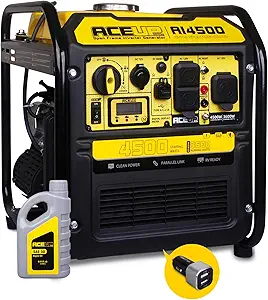What Can a 5000-Watt Generator Run?
What Can a 3500 Watts Generator Run?
April 19, 2025What Size Generator Do I Need to Run a Refrigerator?
April 19, 2025A 5000-watt generator is a powerful and versatile backup power source for both home and work environments. Whether you’re preparing for emergencies, powering a job site, or planning an outdoor event, knowing what a 5000-watt generator can run is essential. In this guide, we’ll break down the appliances and tools a 5000-watt generator can support, factors that affect its performance, and tips for optimal use.
Understanding Wattage and Power Requirements
Generators are rated in watts, which measure the amount of power they can supply. Appliances and tools have two types of power needs:
- Running watts – The continuous power required to keep an appliance operating.
- Starting watts – The extra power needed to start an appliance, usually for a few seconds.
A 5000-watt generator can provide up to 5000 running watts and may have a slightly higher surge watt capacity to handle starting power demands. To ensure efficient power usage, it is crucial to add up the running watts and consider the starting watts of all devices you intend to power.
Common Appliances and Tools a 5000-Watt Generator Can Run
A 5000-watt generator is capable of running a variety of household and work-related appliances. Below is a list of common items it can power:
Household Appliances
- Refrigerator (700-1200 watts) – Most standard refrigerators run at around 700 watts but can require up to 1200 watts when the compressor starts.
- Freezer (500-1000 watts) – Similar to refrigerators, freezers require extra power to start.
- Microwave (800-1200 watts) – Standard microwaves fall within the generator’s capacity.
- Electric Stove (1500-3000 watts) – A single burner may be used, but using multiple burners could exceed the wattage limit.
- Coffee Maker (600-1200 watts) – Easily powered within the generator’s range.
- Washing Machine (900-1500 watts) – Can run efficiently but may require power management when running alongside other appliances.
- Sump Pump (750-1500 watts) – A medium-sized sump pump can run on a 5000-watt generator, but larger models may require more power.
- Water Heater (3000-4500 watts) – Only smaller electric water heaters may be feasible within the generator’s range.
Heating & Cooling Appliances
- Space Heater (1000-1500 watts) – One standard space heater can be run comfortably.
- Window AC Unit (1000-2000 watts) – Small to medium-sized air conditioners can be powered, but larger units may require more wattage.
- Ceiling Fans (50-100 watts each) – Several ceiling fans can run simultaneously.
Electronics & Lights
- LED or CFL Lights (5-20 watts each) – Several lights can be powered simultaneously with minimal wattage use.
- TV (100-400 watts) – Most LED and LCD TVs fall within this range.
- Laptop (50-100 watts) – Multiple laptops can be charged and used.
- Wi-Fi Router (5-20 watts) – Consumes very little power, making it easy to keep internet access running.
Power Tools
- Drill (500-1000 watts) – Most power drills are within range.
- Circular Saw (1200-1800 watts) – Can be powered effectively but may require power management.
- Air Compressor (1000-2000 watts) – Small to medium air compressors can run on a 5000-watt generator.
- Table Saw (1800-2200 watts) – Some models may require more power at startup, so check specifications.
Factors That Affect Generator Performance
- Simultaneous Usage: While a 5000-watt generator can power multiple devices, running too many at once can exceed the generator’s capacity. Prioritize essential appliances.
- Starting Wattage: Devices with motors, such as refrigerators and power tools, require additional startup watts. Be mindful of these surges.
- Fuel Type & Efficiency: Generators can run on gasoline, propane, or diesel. Fuel efficiency and tank size determine how long your generator will operate.
- Extension Cords & Load Distribution: Using heavy-duty extension cords and distributing loads evenly across the generator’s outlets prevents overload and ensures efficient operation.
- Maintenance & Weather Conditions: Regular maintenance, including oil changes and air filter replacements, extends the lifespan of the generator. Avoid running the generator in extreme weather conditions without proper shelter.
Tips for Efficient Generator Use
- Prioritize Essential Appliances: Decide which appliances are most important in an outage and run them accordingly.
- Monitor Power Usage: Keep track of total watts being used to avoid overloading the generator.
- Use Surge Protectors: Protect electronics from power fluctuations.
- Refuel Safely: Turn off the generator and let it cool before adding fuel to prevent fire hazards.
- Keep a Backup Fuel Supply: Having extra fuel ensures extended use during emergencies.
A 5000-watt generator is a reliable source of backup power that can handle multiple household appliances, power tools, and essential electronics. By understanding wattage requirements and managing loads efficiently, you can maximize its performance for home, work, or recreational use. Always follow safety guidelines and manufacturer instructions to ensure a smooth and hassle-free power supply experience.

